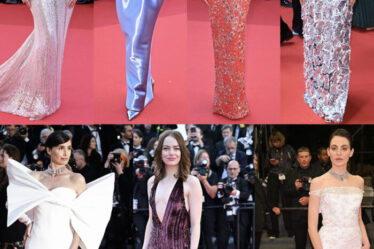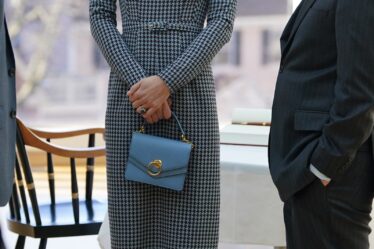This year, for the BoF 500 Gala event held at the Shangri-La Paris during Paris Fashion Week, presenting partner Snap Inc. showcased one of the ways in which augmented reality (AR) can subtly yet effectively engage communities and consumers alike in fashion and beauty.
AR technology is fast becoming a ubiquitous feature of daily life, as physical and digital events coalesce and retailers continue to innovate paths to purchase. Deloitte research for Snap Inc. found that by 2025, nearly 75 percent of the global population — and almost all smartphone users — will be frequent AR users.
AR is core to the Snapchat experience — on average, more than 70 percent of its community engages with augmented reality to communicate, play and learn every day. Snap Inc.’s Lens have also proven a powerful tool designed for artists and developers to create AR experiences for millions of Snapchat users across the world. Lens are outfitted with an extensive set of built-in features, including custom shades and advanced tracking technology.
Indeed, nearly 2.5 million Lenses have been created through Snap Inc.’s Lens Studio (available across Snapchat, Snap Camera, Spectacles and Camera Kit) as well as being viewed over 3.5 trillion times through Snap Inc.’s Creator Community.
Two of Snap Inc.’s AR mirrors were integrated into the 18th century decoration of the Shangri-La Paris’ Salon de Famille and Salle á Manger. The installations, built by OBO agency, were displayed as an optical illusion in order to seamlessly embed the AR mirrors for guests to use.
The AR mirrors at the BoF 500 Gala incorporated this Lens technology, featured in life-size displays. Guests were introduced to the experience through a bespoke BoF 500 Lens, branded digital fashion try-on technology, and other filters.
Now, BoF sits down with Geoffrey Perez, Snap Inc.’s global head of luxury, to discover how AR activations and technology are shaping the fashion and luxury industries with the future in mind.
What opportunities are available to partners that utilise AR?
In the past 18 months, we’ve had 250 million people engaging with AR shopping Lenses on the platform, bridging the gap between virtual and real life habits.
We have many clients using AR in different ways. For example, Tiffany & Co. recently leveraged it for their London exhibition at the Saatchi Gallery, offering an omnichannel journey to visitors which included Snap Inc.’s technologies in various ways. Not only was the Tiffany Diamond available for people to try-on within Tiffany’s own app (including Snap’s Camera Kit technology), but Tiffany & Co. also had a landmark AR Lens covering the whole site facade of the Gallery. On top of that, a couple more AR Lenses were made available on Tiffany’s public profile on Snapchat. This, to me, was one of the best use cases of our technology in an omnichannel experience.
What we do with fashion and beauty brands is about creating seamless experiences of virtual try-ons. Whether it is bags, sneakers, watches, eyewear, jewellery — whatever it is — we have one of the most advanced technologies in terms of AR try-on.
How does AR adoption improve the consumer experience?
There’s been a friction in the past, which was either, “I need to go into a store to try on [a product],” or “I’m going to order three of the same ones in different sizes to see how it fits on me.” But in 2021, some 20 percent of online-bought products were returned [according to Shopify data]. Globally, in 2019, there was $550 billion of waste in the retail industry — mainly returns.
We are trying to avoid that with AR and make sure that we have the right set of tools for people to have the right fit and the right size. It’s been a couple of years that we have been trying to increase the accuracy within the fitting and the sizing of all of our AR tools.
In the past 18 months, we’ve had 250 million people engaging with AR shopping Lenses.
To aid us in that journey, we acquired several companies in the AR and Shopping spaces such as FitAnalytics, Vertebrae, Screenshop or Forma. FitAnalytics, for example, is the sizing tool used by hundreds of retailers, available on their website, to help people find their right size.
Sizing and fitting is still a challenge but we’re trying to bridge that gap and have made remarkable progress over the past years, now offering many products true-to-scale — whether it’s eyewear or bags, for example. We noticed that trying something that is actually your size reduces returns.
What role can AR play in marketing strategies?
If you look at fashion and luxury brands, they’re all about creativity and innovation. The two main canvases available today for brands are either print or video. AR is a new dimension of creation that’s offered to them, used by hundreds of millions of Snapchatters everyday. Not only can you try-on all sorts of products with AR, but you can also tell the story, and that’s what we’ve actually been doing for years.
People have forgotten for quite some time that AR is not only good for trial, but it’s also a very powerful tool for telling stories in new ways, because AR is an open canvas. Anything is possible. I really believe that we should not only think as a commerce play, but also as a “brand” play, and leverage it for either a brand consideration on engagement or even trial and then purchase.
AR is not only good for trial, but it’s also a very powerful tool for telling stories in new ways.
What is the next focus for the company?
In the past 10 years, the whole industry was focused on accelerating checkout — making sure that card and shipping details that you had with was here, and you could check out the easiest and simplest way possible. At Snap, we have always been focusing on the shopper and the human behind to offer an elevated shopping experience — recentring around the shopper, rather than the product.
So, we are looking at how a product fits on the consumer, rather than how it looks on the website. For example, Dior, with their B27 sneakers, recorded a 6x return on ad spend. We also had Gucci, Prada, Cartier, Balenciaga, Louis Vuitton — so many different brands and diverse use cases — whether it’s jewellery, fashion or beauty. All have found success on the platform via engaging in AR, with the shopping experience delivering higher return on advertising as well as higher brand recall.
Everybody’s talking about when Web 1.0 was on fixed desks and where looking for information was the main use case of that version of the internet. Then, Web 2.0 came with mobile and the convenience and easy access to communication, social media, instant messaging, and these were the ultimate function of Web 2.0. For the next version of the Web, we strongly believe it is going to be about experiences, and these are going to be fuelled by augmented reality. We strongly believe that the next computing platform is going to be about AR.
How do you support the next generation of talent and content creators?
There are two types of community— the brands community and the Creators community. The creator communities are pushing the boundaries of tech each and every day. This is why in 2018/2019, we decided to have the Lens studio be freely available to anyone. The Lens Studio is a 3D AR software that we’ve built, and we are working closely with members of the Creator economy to create a network for the best creators in the world.
There’s that relationship that we have with the creators on the platform. We’ve highlighted the best and we are going to make sure these people succeed and they’re pushing the boundaries. Then, we have the brands. If you look at the luxury and fashion industry, they’re always pushing the boundaries, always going further and we learn a lot from them as well. We have the most creative minds in that room over there.
This is a sponsored feature paid for by Snap Inc. as part of a BoF partnership.



